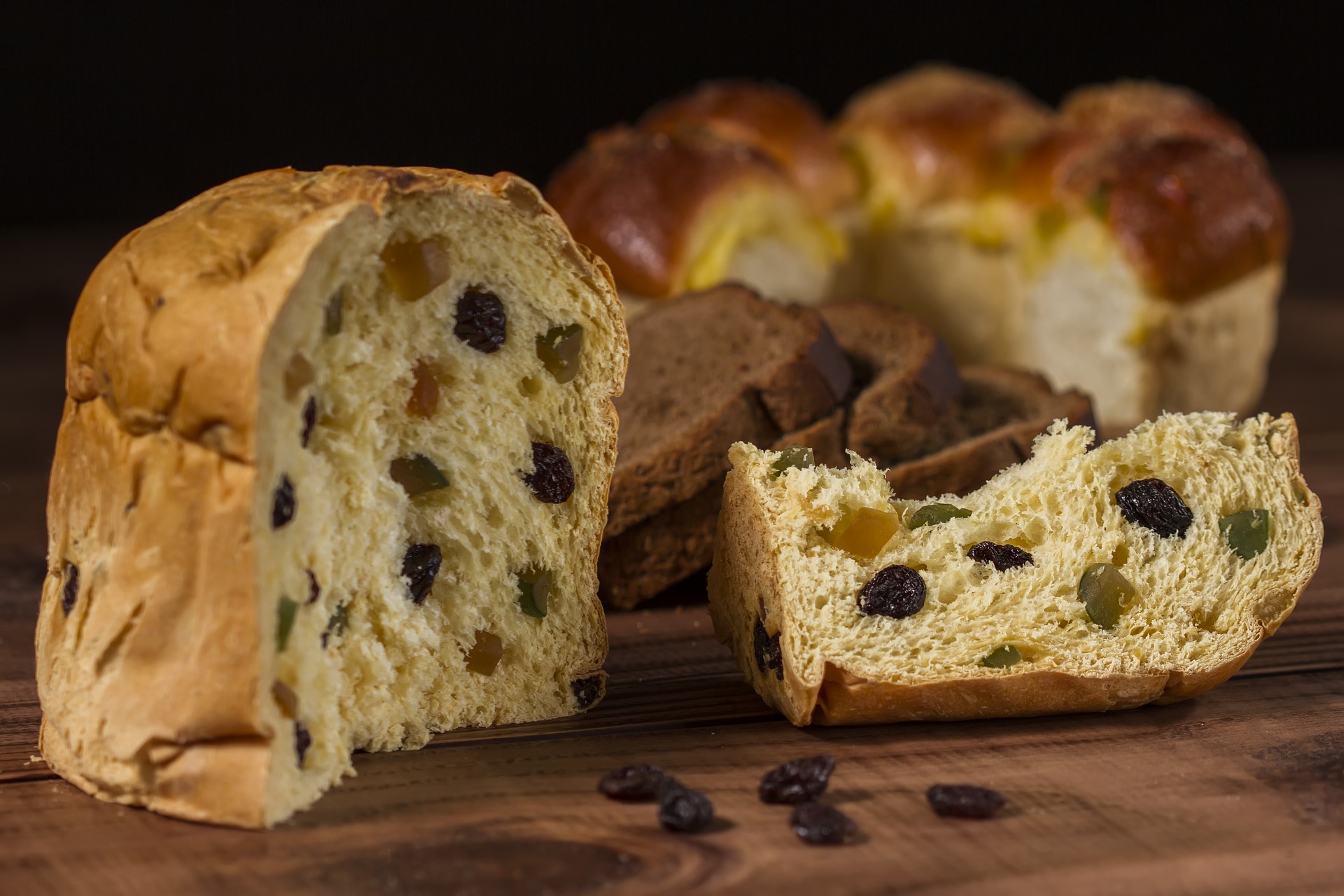- HOME
- Our Recipes
- Italian Panettone
You come to Italy thinking it will be a trip. You leave knowing it was a beginning
Italian Panettone
The Taste of an Italian Christmas
The perfect Italian recipe for you is____? Our quiz holds the answer.
Italian Panettone is world-famous and no Christmas in Italy (view guide) would be complete without this classic Italian Christmas cake.
You may well be surprised to discover that Panettone is not at all difficult to make and it is always way tastier when homemade.
So why not make this Christmas an Italian Christmas? Start baking your very own homemade Italian panettone.
Ingredients
For the Biga (make ahead):
- 1 cup (120g) All-Purpose Flour
- 1/3 cup (80 ml) Lukewarm Water
- 1/4 tsp Active Dry Yeast
For the Dough:
- The prepared Biga 3 cups (360g)
- All-Purpose Flour
- 1/2 tsp Salt
- 1/2 cup (100g) Sugar
- 4 large Eggs, room temperature
- 1/2 cup (115g) unsalted Butter, very soft
- 1 tbsp Orange Zest
- 1 tsp Vanilla Extract
For the Fruit:
- 1 cup (150 g) mixed dried fruit & candied peel, soaked in 1/4 cup brandy/rum/juice.
Instructions
Step 1: Prepare the Biga (The Night Before Baking)
- In a small bowl, combine 1 cup (120 g) of the flour, 1/3 cup (80 ml) of lukewarm water, and 1/4 teaspoon of the yeast.
- Mix until it forms a shaggy dough. Knead for a few minutes on a lightly floured surface until smooth.
- Place the biga in a lightly oiled bowl, cover tightly with plastic wrap, and let it ferment at room temperature for 2-4 hours until it has expanded and become bubbly.
- Refrigerate the biga for at least 12 hours, or up to 24 hours. It will rise slowly and develop flavor.
Step 2: Prepare the Fruit (30+ Minutes Before Making Dough)
Soak 1 cup (150 g) of mixed dried fruit in 1/4 cup of warm brandy, rum, or orange juice. Set aside.
Step 3: Create the Dough Base (Sponge)
- Take the chilled biga out of the refrigerator and let it warm up slightly for 20-30 minutes.
- Tear it into small pieces.
- In the bowl of a stand mixer, combine the biga pieces with the remaining yeast and 1/4 cup (60 ml) of lukewarm water. Add about 1/2 cup (60 g) of the remaining flour to create a thick, sticky "sponge."
- Cover the bowl and let this sponge rest for 30-45 minutes until it becomes very bubbly and active.
Step 4: Develop the Dough Structure.
- Fit the mixer with the paddle attachment.
- Add the 4 large eggs and 1/2 cup (100 g) sugar to the sponge.
- Mix on medium speed for 5-7 minutes until the mixture is very smooth, pale, and slightly thickened. Switch to the dough hook.
- Gradually add the remaining flour (2.5 cups / 300 g) and 1/2 teaspoon of salt. Knead on medium speed for 5-7 minutes until the dough is smooth and elastic. It will be very soft and sticky.
Step 5: Incorporate the Butter (The Key Step)
With the mixer running on low speed, add the softened butter, one tablespoon at a time. It is crucial to wait for each piece of butter to be fully absorbed into the dough before adding the next. This process will take about 5-10 minutes. Once all the butter is incorporated, continue kneading with the dough hook for another 5-10 minutes until the dough is very smooth, shiny, and pulls away from the sides of the bowl. It will still be soft and tacky, but not overly sticky.
Step 6: First Rise (Bulk Fermentation)
Place the dough in a large, lightly greased bowl. Cover it tightly with plastic wrap. Let it rise in a warm, draft-free place for 2 to 4 hours, or until it has nearly tripled in size. This long, slow rise is essential for flavor development.
Step 7: Add Fruit and Shape
Drain the soaked fruit well. Gently turn the risen dough out onto a lightly floured surface. Flatten the dough into a rectangle and sprinkle the drained fruit over it. Fold the dough over and gently knead just until the fruit is evenly distributed. Be careful not to deflate the dough too much. Shape the dough into a smooth ball.
Step 8: Second Rise (Proofing in the Mold)
- Place the dough ball into a well-buttered 7-inch (18 cm) panettone mold or a panettone paper mold placed on a baking sheet.
- Cover the mold loosely with a clean kitchen towel or plastic wrap.
- Let it proof for 2 to 3 hours, or until the dough has risen to about 1-2 inches (3-5 cm) above the rim of the mold. This high-rise is critical for the classic domed shape.
Step 9: Bake and Cool
- Preheat your oven to 350°F (180°C). Just before baking, use a sharp knife or scissors to cut a deep cross (an "X") into the top of the dough.
- Place a small knob of butter (about 1 tsp) in the center of the cross.
- Bake for 10 minutes at 350°F, then reduce the oven temperature to 325°F (160°C).
- Bake for an additional 35-50 minutes, until the top is a deep golden brown and a long skewer inserted into the center comes out clean. If the top browns too quickly, tent it loosely with aluminum foil.
CRITICAL COOLING STEP:
Immediately upon removing it from the oven, take the panettone (in its paper mold) and carefully push two long wooden skewers through the bottom, about halfway up. Hang the panettone upside down by balancing the skewers between the backs of two chairs or tall jars. Let it hang until it is completely cool. This prevents the delicate structure from collapsing under its own weight.
Your Panettone Questions Answered
What is Panettone?
Panettone is a traditional Italian sweet bread originating from Milan. It is a festive treat typically enjoyed during the Christmas season. Panettone is characterized by its dome shape, soft and airy texture, and is studded with candied fruits and raisins. It often comes in decorative packaging and is a popular gift during the holidays.
When is panettone typically consumed?
Panettone is a staple during the Christmas season in Italy. It is often enjoyed on Christmas Eve or Christmas Day. Nowadays, panettone is enjoyed throughout the year. In recent years, its popularity has spread globally, and many people around the world now incorporate Panettone into their festive celebrations.
What is the origin of panettone?
The origin of Panettone, the iconic Italian Christmas sweet bread, is steeped in legend and history. The word "Panettone" itself is believed to derive from "panetto," meaning small bread loaf, with the diminutive suffix "-one" added to convey its larger, dome-shaped form.
One popular legend traces the origins of Panettone to the 15th century in Milan, Italy. The story involves a young nobleman named Ughetto degli Atellani, who fell in love with the daughter of a poor baker named Toni. In an attempt to win her heart, Ughetto disguised himself as a baker's apprentice and created a rich, sweet bread using butter, eggs, candied fruits, and raisins. The resulting creation, Panettone, not only won Ughetto the girl's affection but also became a sensation, gaining popularity among the Milanese elite.
Historically, panettone has been linked to Christmas and festive celebrations. It is said that the Christmas Eve feast of the Duke Ludovico il Moro in 1490 featured the grand presence of Panettone, cementing its association with the holiday season. Over the centuries, the bread evolved, with different regions in Italy developing their own variations.
While the legend of Ughetto degli Atellani adds a romantic touch to Panettone's origin, historical records also suggest that sweet, leavened breads have been enjoyed in Italy since Roman times. The use of natural fermentation to create a light and airy texture became a hallmark of Panettone, setting it apart from other bread varieties.
Is panettone only available in traditional flavors?
While the classic Panettone features candied fruits and raisins, there are numerous variations available to suit different tastes. Some modern twists include chocolate chips, various glazes, or fillings such as cream or fruit compote. Additionally, artisanal bakers often experiment with unique flavor combinations to offer a diverse range of panettone options.
How should panettone be served?
Panettone is typically sliced into wedges, like a cake, and served at room temperature. It can be enjoyed on its own or paired with beverages such as coffee, tea, or sweet wines. Some people like to enhance the experience by toasting or grilling slices and serving them with a dollop of mascarpone or a drizzle of chocolate.
- For more great Italian and Piedmont recipes be sure to get yourself a copy of the absolutely wonderful: Autumn in Piemonte: Food and Travels in Italy's Northwest.
Print this recipe....

If you enjoy my site, I'd love your support.
All you need to do is book your accommodation via this link or any of the other hotel links on the website. Whether it's for travel to Italy... or anywhere else on earth, your support means the world to us.
You'll get the best deal available, and the income helps us stay independent and keep bringing you the best of Italy.
- HOME
- Our Recipes
- Italian Panettone











New! Comments
Have your say about what you just read! Leave me a comment in the box below.